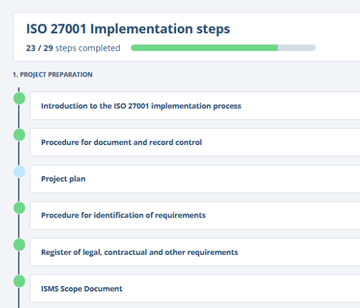In an effort to join other management system standards and their common formats, IATF 16949 replaced the terms “documented procedure” and “record” with the common “documented information” throughout the text. Whereas past versions of the standard mentioned documented procedures – for example, for process definition, control, or support – the newest revision mandates the retention of documented information. And, where previous revisions specified records, the new revision requires the maintenance of documented information. Throughout the IATF 16949 standard, requirements are described and helpful examples are provided.
The IATF 16949:2016 standard is based on ISO 9001:2015, which means that it contains all of the requirements listed in ISO 9001 concerning documented information, as well as additional mandatory documentation.
The following is the list of mandatory needed for IATF 16949 implementation.
Mandatory documents and records required by IATF 16949:2016
- Scope of the quality management system (clause 4.3)
- Documented process for the management of product safety related products and manufacturing processes (clause 4.4.1.2)
- Quality policy (clause 5.2)
- Responsibilities and authorities to ensure that customer requirements are met (clause 5.3.1)
- Results of risk analysis (clause 6.1.2.1)
- Preventive action record (clause 6.1.2.2)
- Contingency plan (clause 6.1.2.3)
- Quality objectives (clause 6.2)
- Records of customer acceptance of alternative measurement methods (clause 7.1.5.1.1)
- Documented process for managing calibration/verification records (clause 7.1.5.2.1)
- Maintenance and calibration record (clause 7.1.5.2.1)
- Documented process for identification of training needs including awareness and achieving awareness (clause 7.2.1)
- Documented process to verify competence of internal auditors (clause 7.2.3)
- List of qualified internal auditors (clause 7.2.3)
- Documented information on trainer’s competency (clause 7.2.3)
- Documented information on employee’s awareness (clause 7.3.1)
- Documented process to motivate employees (clause 7.3.2)
- Quality manual (clause 7.5.1.1)
- Record retention policy (clause 7.5.3.2.1)
- Documented process for review, distribution and implementation of customer engineering standards/specifications (clause 7.5.3.2.2)
- Registry of customer complaints (clause 8.2)
- Product/service requirements review records (clause 8.2.3.2)
- Procedure for design and development (clause 8.3.1.1)
- Record about design and development outputs review (clause 8.3.2)
- Documented information on software development capability self-assessment (clause 8.3.2.3)
- Records about product design and development inputs (clause 8.3.3.1)
- Records about manufacturing process design input requirements (clause 8.3.3.2)
- Document a process to identify special characteristics (clause 8.3.3.3)
- Records of design and development controls (clause 8.3.4)
- Documented product approval (clause 8.3.4.4)
- Records of design and development outputs (clause 8.3.5)
- Manufacturing process design output (clause 8.3.5.2)
- Design and development changes records (clause 8.3.6)
- Documented approval or waiver of the customer regarding the changes in design (clause 8.3.6.1)
- Documented revision level of software and hardware as part of the change record (clause 8.3.6.1)
- Documented supplier selection process (clause 8.4.1.2)
- Documented process to identify and control externally provided processes, products and services (clause 8.4.2.1)
- Documented process to ensure compliance with statutory and regulatory requirements of purchased processes, products and services (clause 8.4.2.2)
- Documented process and criteria for supplier evaluation (clause 8.4.2.4)
- Records of second-party audit reports (clause 8.4.2.4.1)
- Characteristics of product to be produced and service to be provided (clause 8.5.1)
- Control plan (8.5.1.1)
- Total productive maintenance system (clause 8.5.1.5)
- Records of traceability (clause 8.5.2.1)
- Records about customer property (clause 8.5.3)
- Production/service provision change control records (clause 8.5.6)
- Documented process to control and react to changes in product realization (clause 8.5.6.1)
- Documented approval by the customer prior to implementation of the change (clause 8.5.6.1)
- Documented process for management of the use of alternate control methods (clause 8.5.6.1.1)
- Record of conformity of product/service with acceptance criteria (clause 8.6)
- Record of expiration date or quantity authorized under concession (clause 8.7.1.1)
- Documented process for rework confirmation (clause 8.7.1.4)
- Record on disposition of reworked product (clause 8.7.1.4)
- Documented process for repair confirmation (clause 8.7.1.5)
- Record of customer authorization for concession of the product to be repaired (clause 8.7.1.5)
- Notification to the customer about the nonconformity (clause 8.7.1.6)
- Documented process for disposition of nonconforming product (clause 8.7.1.7)
- Record of nonconforming outputs (clause 8.7.2)
- Monitoring and measurement results (clause 9.1.1)
- Internal audit program (clause 9.2)
- Results of internal audits (clause 9.2)
- Documented internal audit process (clause 9.2.2.1)
- Results of the management review (clause 9.3)
- Action plan when customer performance targets are not met (clause 9.3.3.1)
- Results of corrective actions (clause 10.1)
- Documented process for problem solving (clause 10.2.3)
- Documented process to determine the use of error-proofing methodologies (clause 10.2.4)
- Documented process for continual improvement (clause 10.3.1)
And, there you have it! So, how do you feel about it? Does it seem like too much to write? Do these documents address all elements of quality management?
Click here to download a white paper Checklist of Mandatory Documentation Required by IATF 16949:2016 with more detailed information on the most common ways for structuring and implementing mandatory documents and records.


 Strahinja Stojanovic
Strahinja Stojanovic 


